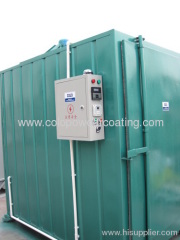



Powder Coating Cure Ovens
| Min. Order: | 1 Piece/Pieces |
|---|---|
| Trade Term: | FOB |
| Payment Terms: | L/C, T/T, paypal, WU |
| Supply Ability: | 500pieces per year |
| Place of Origin: | Zhejiang |
Company Profile
| Location: | Hangzhou, Zhejiang, China (Mainland) |
|---|---|
| Business Type: | Manufacturer, Distributor/Wholesaler |
Product Detail
| Model No.: | electric heat cure oven |
|---|---|
| Means of Transport: | Ocean, Air |
| Brand Name: | colo |
| Condition: | new |
| type: | powder curing oven |
| Substrate: | iron |
| coating: | powder coating |
| powder coating equipment: | powder curing oven |
| Production Capacity: | 500pieces per year |
| Packing: | wood case |
| Delivery Date: | 5-15days |
Product Description
Powder materials are thermally reactive by design, meaning that heat will change them. The heat required to transform the powder material from its powder form to a solid thermosetting finish comes from an oven. There are several types of ovens to choose from. Natural Gas Convection heat, infrared, and electric heat are the most popular.
Without getting into the direct pros and cons about each heating system, I would like to discuss several of the important factors regarding the heating system that directly effect the quality of the finish.
1. Proper air flow within in the oven is very important. The direction and the velocity of the air should be taken into consideration when designing and/or adjusting the oven. The recirculating blower size must be calculated correctly to determine the proper flow and direction of air. Contact your oven manufacturer if you think that changes need to be made.
2. Even heat distribution is needed to insure that the parts will receive the proper amount of temperature for the correct time. By changing the distance in the openings between the louvres inside the ovens, on a gas fired convection heat oven, for example, you can change the atmospheric temperature and redirect the air flow in certain areas within the oven.
3. Clean oven intake or burner air is essential to prevent contamination from entering the heated air space within the oven walls. I have helped a number of companies correct contamination problems by instructing them to change or add a filtration device to the oven air intake system. Contaminants that enter the oven will be carried rapidly to the parts by the recirculating blowers and can eventually be embedded into the finish before it completes the cure cycle.
4. Total heating time is the sum of the time that it takes for the parts to reach the predetermined cure temperature plus the time that is required for the part to remain at that temperature to complete full cure. To accurately determine the total oven time it is helpful to send a temperature recorder into the oven with a probe attached to the parts surface and another that will measure the oven atmospheric temperature. Most powder sales representatives will be happy to help you run such a test. Once the total oven time is determined for the given mass, or part, some type of timing system must be implemented to insure that the parts are exposed to the necessary heat for the proper time. Conveyorized ovens use line speeds to establish the total oven duration. Batch finishers will use some sort of timer with a bell or flashing light to remind the coating applicators that the parts are to be removed from the oven. 
5. Housekeeping is one subject that I cannot write enough about and for good cause. If contamination is abundant on the shop floor of any plant that I visit, I will bet good money that the inside of the oven, spray booth, collector system, powder hopper, etc. will also contain the same contaminants. Shop air flow is constantly moving and changing. Lift trucks moving about, doors opening and closing, fan and air conditioners blowing, compressed air being used for part blow off and many more factors involving air movement will cause contaminants such as dirt, lint, hair, and trash to be introduced into the finishing system. The powder coating application system is very dependent on clean dry air. Therefore, good housekeeping should not be something that you have your line workers do when you're not busy, it should be apart of the total quality commitment in any finishing shop, FULL TIME!
6. Record keeping of maintenance tasks such as, oven calibration, filter changes, motor repair or replacement, and oven adjustments should always be logged in a maintenance book. This maintenance log book will allow the systems manager to spot trends and help to insure that the system is being closely watched for changes that will effect productivity and quality. I like to see an oven that has a temperature recording device attached to it as an option. In fact, I have had customers request proof of the oven temperature during the run of their parts. Contact your oven manufacturer and ask about the options available.
7. Ovens require little maintenance as compared to the pretreatment system for example. However, all equipment should be maintained on a regular basis to prevent devastating unplanned down time. Schedule clean up and inspection time for ovens as with all equipment to insure that they are operating at peak efficiencies.
8. Calibration and temperature testing should be done on a regular basis by your equipment supplier to insure that all is well. Like a physical examination by a doctor sometimes we need a second opinion regarding the health and condition of our system.
Air Flow
Even Heat Distribution
Clean Oven or Burner Intake Air
Total Heating Time
Housekeeping
Record keeping
Maintenance
Calibration and Temperature Testing
The above can be used as a check list for developing a regular maintenance inspection on your heating system.







